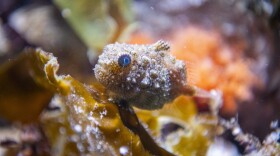Don't be tricked by their appearance — fangblenny fish aren't just a cute face. They use special opioid-based venom to avoid being eaten.
The fish are 2 inches long and live in places such as Australia's Great Barrier Reef. When one is caught and swallowed up by a predator, the blenny literally bites its way out. The venom disorients the bigger fish, and the blenny escapes to freedom.
Bryan Fry, an associate professor at the University of Queensland in Australia, leads a group of researchers that has learned more about how venomous fangblennies do their thing.
The first step was to get some venom from the fangblenny fangs. Researchers had to pull the blennies out of a fish tank using a net. Then "we would just put a little cotton swab in front of them and they would instantly bite it and seconds later they were back in the water," Fry says.
His group studied the chemical makeup of the blennies' toxin. The venom contains components similar to those found in the venom of scorpions. Surprisingly, it also contains an opioid peptide similar to those in painkillers. The researchers' findings were published in the journal Current Biology on Wednesday.
When the researchers injected the blenny venom into mice, it didn't seem to cause the mice any pain.

This came as a big surprise, Fry says. "We expected that ... it's a defensive venom, so it's going to hurt like every other defensive venom," he adds.
Fry believes the venom causes the larger fish to become dizzy. The disorientation allows the little fang-fish to give it the slip.
"Dizziness brought about by low blood pressure is a very common side effect for any kind of opioid. In this case, the side effect is what's being used by the blenny," he says.
Fry says studying the unique opioid peptides in the fangblenny venom could be beneficial in the future. He thinks it's possible that researchers could stumble on a useful opioid drug.
"If you have one that's a bit less potent but a lot less addictive than something like Vicodin, that's already going to be a good thing."
According to Fry, that's one of the many arguments for conserving places such as the Great Barrier Reef. "You have these beautiful little fish that could potentially yield the next wonder drug, but we can't do that if these animals aren't around."
Copyright 2021 NPR. To see more, visit https://www.npr.org.








